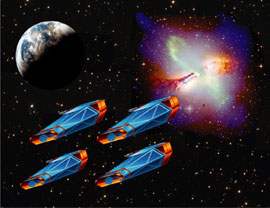 Posters abstracts
Posters abstracts
| Session 2: Future Missions | |||||||
2-1 Marie-Claire Perkinson (EADS Astrium)
Accommodation Challenges for the XEUS Payload Module
The instrumentation for the XEUS telescope
represents a performance and technological
leap forward from past and present X-ray
missions. This is also achieved through a
novel telescope design, where the focal
plane is separated from the telescope
mirror. However, these innovations also
demand a novel approach and technologies for
the design and accommodation of the payload
on the detector spacecraft.
The absence of a telescope tube means that
all the instruments are potentially exposed
to a wide range of unwanted particles and
radiation from the surrounding environment.
This includes electromagnetic radiation
(X-rays from outside the instrument field of
view, stray visible-UV and near IR light
from the Sun and the metrology system,
thermal radiation from the mirror itself),
charged particles (channelled by the Earth-Sun
magnetic field), background radiation
and molecular contamination (outgassing from
the detector spacecraft, AOCS propellants,
contaminants from the launch/cruise phase).
All this requires a very detailed and
possibly novel design of the instrument
baffle and shielding system.
Another critical area for the instrument
accommodation is derived from novel detector
technologies, which in turn impose stringent
constraints on the overall payload module
(PLM) design. This is particularly true of
the Narrow Field Instruments (NFI) which
combine very low temperature (mK range) with
long lifetime requirements (5 years, goal 10
years) and high susceptibility to magnetic
fields. These detectors require cooler
solutions that are new for space
applications and a detailed assessment of
the complete cryogenic chain is therefore
required.
The XEUS PLM options and system trades are
the subject of a payload accommodation study
to be carried out in 2006. The key system
level trade-off is the thermal mechanical
architecture which includes the payload
location options (core or extended
instrument suite, separate or co-aligned),
the baffle options (for electromagnetic
radiation and particles) and the sunshield
options. This paper will address the
critical issues for the accommodation of the
XEUS instruments.
2-2 Jean Cottam (NASA/GSFC)
The Constellation-X Reflection Grating Spectrometer
The Reflection Grating Spectrometer on the Constellation-X mission will provide high sensitivity, high-resolution spectra in the soft x-ray band. The RGS performance requirements are specified as a resolving power of greater than 300 and an effective area of greater than 1000 cm^2 across most of the 0.25 to 2.0 keV band. These requirements are driven by the science goals of the mission. We will describe the performance requirements and goals, the reference design of the spectrometer, and examples of science cases where we expect data from the RGS to significantly advance our current understanding of the universe.
| Session 3: Clusters of Galaxies | |||||||
3-1 Richard Lieu (University of Alabama)
A Detailed Comparison of WMAP and X-ray Data for a Sample of 31 Clusters of Galaxies - the Absence of Sunyaev-Zel'dovich Effect
The WMAP Q, V, and W band radial profiles of
temperature deviation of the CMB were
constructed for a sample of 31 randomly
selected nearby clusters of galaxies in
directions of Galactic latitude
|b| > 30 degrees. The profiles were compared in detail
with the expected CMB Sunyaev-Zel'dovich
effect (SZE) caused by these clusters, with
the hot gas properties of each cluster
obtained directly from X-ray observations,
and with the WMAP point spread function
fully taken into consideration. While the
WMAP profiles of some clusters do exhibit
the SZE, the phenomenon is also noted to be
weak or absent from other clusters.
A reliable overall assessment can be made
using the combined (co-added) datasets of
all 31 clusters. The verdict is that the
observed SZE only accounts for about 1/4 of
the expected decrement. Contamination of
the SZE signal by cluster radio sources is
excluded by statistical occurrence rate of
such sources as determined from SZ surveys,
by the WMAP band ratio of the fluxes, and by
the lack of extra CMB temperature
variation within the cluster sample. By
analyzing higher resolution XMM-Newton data,
we examined critically how the X-ray
prediction of the SZE may be affected by a
central cooling flow in clusters, abundance
of the hot cluster gas, large scale radial
decline of the temperature, and
uncertainties in the beta-model. In each
case, it is possible to demonstrate
quantitatively that such effects are too
weak to change our findings. However, the
use of future generations X-ray missions
with high spatial and spectral resolution
will lead to a resolution, concerning
whether the absence of SZE is caused by
hitherto undiscovered physical phenomena at
the cluster cores, or the presence of a
non-cosmological component of the CMB.
3-2 Sandor Molnar (University of Zurich)
Using High Resolution X-ray Spectrometers to Determine Distances to Clusters of Galaxies
Bright clusters of galaxies can be seen out to cosmological distances, and thus they can be used to derive cosmological parameters. Although the continuum X-ray emission from the intra-cluster gas is optically thin, the optical depth of resonant lines of ions of heavy elements can be larger than unity. Determining the spatial distribution of the intra-cluster gas from X-ray imaging and the optical depth from resonant lines one can derive direct physical distances to clusters of galaxies. High resolution X-ray spectroscopy makes it possible to determine the optical depth through clusters using several different methods. The optical depth can be determined using the absorption features of resonant lines in a spectrum of an AGN behind the cluster, or using resonant emission lines. The optical depth in a resonant emission line can be determined from the line profile, from the spatial distribution of the line's intensity, or from the polarization of the line. The most promising methods are those based on line profiles and line intensities. We discuss the spatial and spectral resolutions needed to use resonant emission line profiles for accurate determination of distances, and hence cosmological parameters. We show that accurate distances will be obtained by applying this technique with the next generation of high resolution X-ray spectrometers.
| Session 4: Active Galactic Nuclei | |||||||
4-1 Rebecca Smith (UCL/MSSL)
An Analysis of Markarian 509 RGS Data
We present a detailed analysis of the soft X-ray spectrum of Markarian 509 taken with the Reflection Grating Spectrometer onboard XMM-Newton. The warm absorber is shown to consist of three phases each with a different ionization and column density with outflow velocities ranging from 140 to 492 km/s. Also anlysed is the emission profile, including two broad emission lines due to O VII and C VI, with FWMH = 10300 km/s, and two narrow emission lines due to oxygen.
| Session 6: Stellar Coronae, and Planets | |||||||
6-1 Ton Raassen (SRON)
Variability in the X-ray Spectrum of the Stable Calibration Source Capella
We discuss 10 individual observations over the last five years of the stable calibration source Capella. The lightcurves and spectra, derived from LETGS on board CHANDRA are investigated. The spectra cover the wavelength range 1 - 175 A. Multi-temperature fittings to the total spectra have been made by means of SPEX in combination with MEKAL. Nine of the ten observations show comparable count rates, while one observation (ID=5956) on 2005-03-31 has a 40% higher count rate. No individual flares were recognized. The DEM-modeling of this observation shows a higher emission measure at higher temperature. Individual line flux ratios, when comparing this observation with one of the others, also show an increase for higher formation temperatures. Some time dependence seems present.
6-2 Antonio Maggio (INAF - Osservatorio Astronomico di Palermo)
Benchmark Exercises for stellar X-ray Spectroscopy Testing (BEXST)
In recent years, different teams active in the field of stellar coronal physics have used different approaches for the reduction and analysis of high-resolution spectra taken with Chandra and XMM-Newton. Various methods have been employed, which differ in many respects (numerical algorithms, selection of emission lines, atomic physics databases, free model parameters). At present, there is no study available about whether all the different approaches produce compatible results, or whether some (or all) of them lead to biases in the resulting physical parameters. This situation is made more complex by the growing indications that some of the usual assumptions in the above analyses (uniform densities or pressure equilibrium, steady heating, uniform chemical composition) are in fact invalid. We have organized a "hares and hound exercise" open to the whole community, aimed to address the above issues. This poster presents the rationale for this exercise, its organization, and its status of progress.
| Session 8: X-ray Binaries | |||||||
8-1 Jan-Uwe Ness (Arizona State University)
X-rays from the Classical Nova V723 Cas
The old Classical Nova V723 Cas (1995), has been detected in X-rays with Swift. Previous observations of optical emission lines from highly ionised iron motivated the 7-ksec observation, and the nova was observed to still be active with an X-ray emission level of 7.8E-13 erg/cm^2/s. The spectrum is unusually soft and peaks at about 0.4 keV. This is the first X-ray detection of this nova, but in particular, the first time a nova has been observed to still shine in X-rays after more than 10 years. This is a candidate of a nova turning into a permanent Super Soft X-ray source that has been proposed to be a progenitor of a SN Ia.
